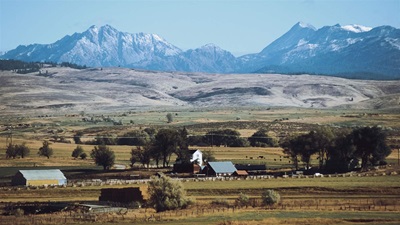How Oregon Can Leverage Its Nature for a Brighter Future
Healthy farms, forests, rivers, and wetlands would protect communities and industries from increasingly severe weather events.

Over Labor Day weekend in 2020, while many Oregonians were celebrating the holiday with friends and family, five megafires—wildfires more than 100,000 acres in size—burned across the state, consuming more than 4,000 homes and nearly 850,000 acres of forest land. The blazes caused severe eye and lung irritation to thousands of residents, cost workers millions of dollars in lost wages and productivity, and delivered a huge blow to Oregon’s already limited housing stock.
In recent years the state has also faced deadly heat waves, extreme freezes, prolonged drought, and other disasters. This pattern, which scientific research has concluded is linked to the changing climate, threatens communities and the natural and working lands—farms, forests, nurseries, ranches, rivers, and wetlands—on which Oregonians rely.
Throughout the state, natural areas provide clean air and water, places for outdoor recreation, and fish and wildlife habitat, all while helping communities prepare for and withstand environmental threats, including extreme weather events, from a changing climate.
Further, Oregon’s public lands and waters are the centerpiece of a thriving outdoor recreation economy that accounted for more than $8 billion of economic activity and supported more than 70,000 jobs in 2023 (the latest figures available). By proactively managing and protecting these lands with future conditions in mind, state leaders can help ensure that people will continue to enjoy—and spend money on—camping, fishing, hiking, birding, skiing, and much more for decades to come.
It is therefore imperative that the state government and communities prepare for a host of impacts, from longer and more intense droughts and wildfire seasons and less predictable quantities—and quality—of freshwater to more invasive species and diseases, changing wildlife migration patterns, and increased sea-level rise. And they can do so by harnessing two of the state’s best assets: its nature and its people.
For example, tidal wetlands have an almost unmatched capacity to capture and store carbon while also reducing the effects of storms and flooding on coastal communities. Similarly, old-growth forests act as powerful carbon sinks, supporting biodiversity while stabilizing local climates and regulating water cycles that benefit both ecosystems and human communities downstream. And high desert grasslands in eastern Oregon play a vital role in carbon sequestration and soil stabilization while supporting resilient habitats that are adapting to the region’s changing climate.
Natural and working lands in Oregon also hold cultural and economic significance for Tribal Nations and local communities, including the Confederated Tribes of the Umatilla Indian Reservation in the Columbia River and Blue Mountains regions of northeast Oregon and southeast Washington. The Tribes’ members rely on forests, grasslands, rangelands, and rivers for "first foods" such as roots, berries, deer, elk, and salmon and for timber and agricultural products. These considerations are part of the Climate Adaptation Plan the Tribes adopted in 2022.
In another encouraging sign, in July 2023 a new Oregon law included an initial $10 million investment to enhance the ability of natural and working lands to sequester and store atmospheric carbon. For example, restoring native vegetation and tidal flow in estuaries—a priority for the Oregon Department of Fish and Wildlife—allows more sediment and other organic matter to accumulate while also slowing down their decomposition, thereby increasing carbon sequestration, fish and wildlife habitat, and buffering communities from storm surges.
The law prioritizes actions like these that promote carbon sequestration while "maintaining or increasing ecosystem resilience and human well-being." The Oregon Climate Action Commission’s Natural and Working Lands Biennial Report to the state Legislature last year details progress to date, as does a more recent presentation to the commission from several natural resource agencies.
And in July, Governor Tina Kotek launched a process to create a Plan for a Resilient Oregon (PRO)—a timely and needed effort to help Oregon communities better prepare for disasters and extreme weather. However, PRO is not designed to manage and protect natural environments from those events and extremes.
Although these accomplishments mark an important beginning, the state should also lay out a clear process for adaptation and resilience work to address the rapid changes—and escalating climate threats—already unfolding. Oregon leaders must therefore adopt policies that include:
- Developing and implementing trackable climate resilience goals for protection, restoration, reconnection, and other conservation measures across Oregon’s natural and working lands and waters.
- Establishing a state and Tribal interagency collaborative that could serve as a central place to co-create goals and share progress.
- Setting a standard that all natural resource management plans monitor and evaluate climate impacts on lands and waters, plan for multiple climate scenarios, set clear goals, adapt as new impacts emerge, and include collaboration with Tribal Nations and local communities.
As Oregon works to harness its natural and working lands to reduce the state's carbon footprint, it must also ensure that these areas can adapt to changes occurring now and into the future. Engagement with Tribal Nations and other communities can identify the most effective ways to ensure resilient landscapes.
By acting now and following the science, Oregon policymakers can help protect residents, visitors, wildlife, habitat, and the vibrant industries—from farming and fishing to timber and tourism—that are central to the state’s heritage, and to its future.
Andrew Maggi and Bobby Hayden are officers with The Pew Charitable Trusts’ U.S. conservation project.








